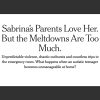Linda Carling, EdD, is an Associate Research Scientist at the Johns Hopkins University School of Education and director of the school’s Center for Technology in Education. She specializes in learning engagement and design and is a parent of a child with a disability.
I was shocked when I read The New York Times’ article “Sabrina’s Parents Love Her. But the Meltdowns Are Too Much.” Pictured front and center is a 13-year-old autistic girl in the middle of a meltdown on the sidewalk surrounded by law enforcement, whose parents are struggling with her challenging behavior.
Fast forward a few years and imagine this same child seeing her photo in the Times like this, or even being recognized and called out on the street by people who read this article. What if a potential future employer recognizes her?
If this child were capable of consent — and I am positing that she is not based on the fact that she is a minor — how would she feel if she read this article or saw the photo of herself prostrate on the floor in a private, painful moment for all of the world to see?
Is it okay because she’s autistic? Where is her voice in the article?
If this were any other circumstance — a child with a serious illness, a child who uses a wheelchair, or a rebellious teen for example — this article would be unconscionable. Without her consent, this child’s violent behaviors and failed treatment attempts are described in clickbait-drenched detail by her family who are (understandably) overwhelmed as caregivers, and these behaviors are linked to having an autism diagnosis.
As if the autistic community and their families didn’t struggle enough with stigma, lack of support resources; the audacious disability sensationalism and violation of an autistic minor’s privacy in this article actually contributes to the problems it (tangentially) discusses by putting yet another negative and exploitative article into circulation. Unfortunately, these sensationalist and exploitative articles are commonplace.
As a parent of a child with autism, I understand how difficult it is to get the resources and support you need for your child. These resources are essential, yet extraordinarily challenging to access for many families, and they become increasingly difficult to access as children get older. As an educator, I know that schools are dealing with staff shortages and large special education caseloads. Families are forced to wait months to years for evaluation and diagnosis appointments and access to the therapies they need.
Much of what we see and read about autism focuses on how autism affects parents, educators, and the community. But how often do we hear the voices of autistic people themselves? When representation falls largely on caretakers and not those who require care — when a majority of what we read about people with autism either features negative behaviors or exceptional, feel-good stories about the people who “sacrifice” themselves and “rescue” people with disabilities — we infantilize, demonize, dehumanize, and perpetuate negative stereotypes about people with autism.
If we lived in a world where ableism didn’t run rampant or where autistic people had equal access to the things neurotypical people had, writing a human interest story on how some parents are struggling — and I do not deny that their struggles are very real — would be less harmful, though I still take issue with consent in this instance.
In the world we do live in where ableism does in fact run rampant, this article is detrimental to the autistic community and feeds into fear and misinformation. Every person with autism is different. The behaviors described in the article refer to a very small subset of people with autism.
If we want to highlight struggles, focus on the struggles experienced by disabled people and their families as a result of limited access to resources. Include more disabled voices and perspectives. And stop using disabled people and their families as clickbait.
Without the voices of consenting autistic individuals, we will not get any closer to understanding and addressing their needs as a society. When we promote negative stereotypes by only featuring negative aspects in a community, it makes it harder for children and families to get the support they need.
I believe Sabrina is fortunate to be a part of a loving and supportive family. I know that families like Sabrina’s are searching for help and some families share similar experiences. Focusing on her worst moments from the parents’ perspective is not the most effective way to tell the story and improve how we support autistic children and youth.
We must do better.

